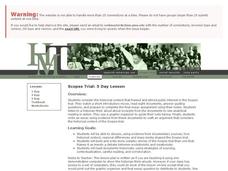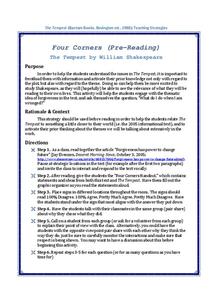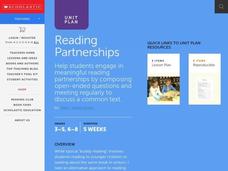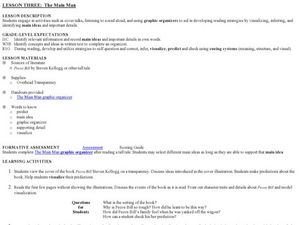Curated OER
The Little Engine that Could Mini Unit Plan
The best part about teaching little ones is setting up fun, thematic learning stations. Here is a full day of activities that all relate to the story, The Little Engine that Could. Included are six different activities that cover art,...
Historical Thinking Matters
Scopes Trial: 5 Day Lesson
Did Scopes violate the Butler Act? Why did so many Americans follow the Scopes trial? See analytical reading in action with a fantastic five-day lesson plan in which class members consider the historical context that provoked public...
Ontario
Critical Literacy—Media Texts
Media texts convey both overt and implied messages. As part of their study of media, class members analyze the language, form, techniques, and aesthetics in a variety of media texts.
Novelinks
Walk Two Moons: Guided Imagery
Sensory details can enhance the reading experience, especially during a guided imagery reading. Young readers close their eyes and listen to a passage from Sharon Creech's Walk Two Moons before responding to discussion questions and...
Bantam Books
The Tempest: Four Corners
Forgiveness can be a difficult step to take in any circumstance, but is it more difficult if the offense is more egregious? High schoolers consider the concept of forgiveness before reading William Shakespeare's The Tempest. As kids read...
Curated OER
“THE LORAX” by Dr. Seuss
Few children's books convey the message of conservation as well as Dr. Seuss' The Lorax. Read the story aloud, emphasizing the interconnectedness of plants and animals in an ecosystem and discussing different ways people can help the...
Curriculum
Expository Writing
The beauty of the way this expository writing resource is structured is that the units can be presented as a complete writing workshop or sequenced throughout a course of study
Curated OER
Run, Gingerbread Men, Run!—Game
Run, gingerbread men! During the board game, four gingerbread men race to discover which one finishes first. Scholars take note of the game's results using a tally chart and bar graph for all to observe the frequency of the winning...
Curated OER
Create a Computer Story
Second graders will create their own story and read it aloud. In this literacy/technology lesson, 2nd graders use computer software to create their own story, which is read back to them while they write it. Afterward, the student should...
Curated OER
Reading Partners
Students participate in several activities using a reading partner. They plan and organize reading meetings with their partner, and then review story elements by retelling the stories orally. The partners question each other and make...
Curated OER
Introduction to Visualization
Fourth graders listen to The Bear's Toothache and illustrate the story in their minds. In this visualization lesson, 4th graders draw pictures of what they hear in a read aloud. Students discuss their pictures and compare and contrast...
Curated OER
Who Am I Without Him?
Students read and discuss the book, Who Am I Without Him? In this fluency lesson, students practice reading with expression and making text to self connections. Students practice writing expressively in their journals.
Curated OER
The Main Man
Students explore visualizing stories by completing a graphic organizer. In this reading strategy lesson, students read the story Pecos Bill by Steven Kellog and identify the setting, main characters and their interpretations. Students...
Curated OER
Thumbs Up For Expert Readers!
Students use the cross check strategy to increase reading comprehension in this lesson. They listen as the teacher reads "Where the Wild Things Are." The teacher purposely reads some words wrong so that the story does not make sense. ...
Curated OER
The better to eat you, dear!
Students practice various strategies for fluent, expressive reading. After reviewing sentence structure, students choose an appropriate leveled book to read with their partner. They are assessed on their reading fluency and reading...
Curated OER
The Miracle of the First Poinsettia
Connecting to literature and learning how to infer are two great reading strategies everyone needs to know. Here, the class will read along with the story The Miracle of the First Poinsettia, review folktales as a genre, and make...
Curated OER
The Raven
After a close reading of Edgar Allan Poe's "The Raven" individuals copy the rhythm and rhyme scheme and rewrite the final stanzas of the poem.
Curated OER
Shizuko’s Daughter: Story Impression
Craft your own fairy tale based on Momotaro, a Japanese story referenced in Kyoko Mori's Shuzuko's Daughter. A list of nouns guide learners in writing their own story, and predicting what might happen in the novel.
Curated OER
Sexual Exploitation, Day 4: Assault Strategies
A delicate topic is the focus of this lesson. Discuss what people can do to reduce the risk of sexual assault, as well as what a person should do if he or she is sexually assaulted. This is not any easy topic to discuss in a classroom,...
Houghton Mifflin Harcourt
Person to Person: English Language Development Lessons (Theme 4)
Help language learners understand words and cultural concepts. The second installment in a series of three language development lessons designed to accompany Theme 4: Person to Person helps bridge the gap for language learners by...
University of North Carolina
Word Choice
Words matter, particularly in academic writing. Issues such as vague language, wordiness, and cliches make it difficult to get a point across. Part of a larger series to improve writing skills, the handout on word choice shows writers...
Curated OER
Spring-Aloud Read
Students study the season of spring and create stories about the season. In this spring season lesson, students read books about spring and discuss the season. Students then color and create a mini-book about Spring.
Curated OER
Reading and Responding: Lesson 24
Fourth graders explore fictional literature. They read a fictional passage and practice answering multiple choice questions about the text they read. Students complete short answer questions.
Curated OER
We All Need Speed Limits
Students consider fluency and speed of reading. In this speed limits lesson, students discuss the importance of speed when reading and how the rate affects comprehension and listening skills. Teacher models think aloud as a strategy.

























